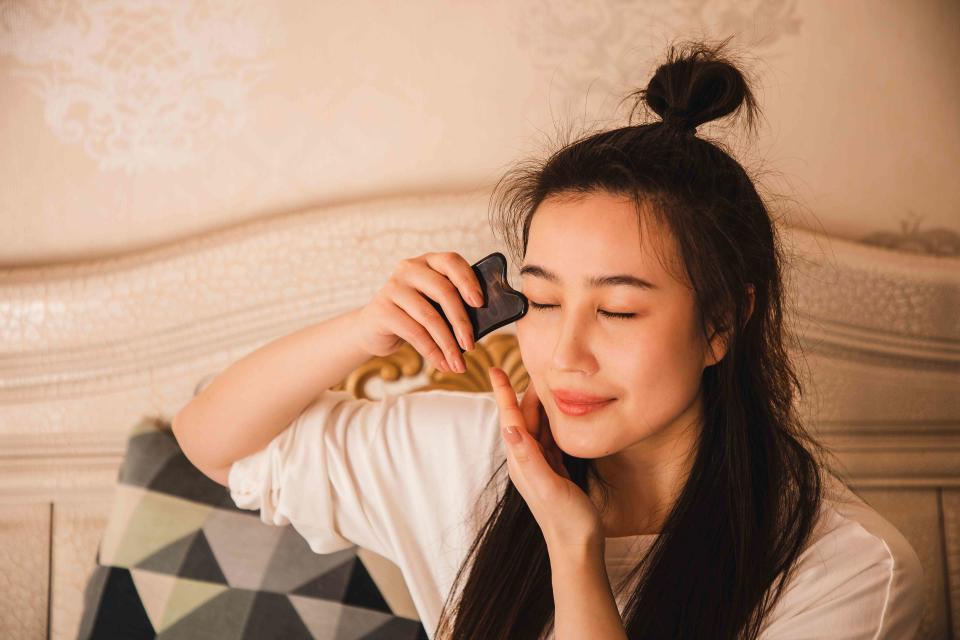You Probably Have Bad Gua Sha Habits
The beauty trend is full of misinformation.

Getty Images
We live in the age of the snatched face: We’re all trying to massage, de-puff, and just generally smush our faces in the pursuit of contoured cheekbones, lifting brows, and a razor-sharp jawline. You can hardly Google any information about how to get rid of a double chin or how to sculpt your face naturally without seeing at least three ads for jade rollers or the newest (and wildly expensive) gua sha tool.
And yes, using a gua sha tool can definitely help you sculpt your face — but many don’t realize is gua sha is actually an incredibly old wellness practice that can offer benefits that extend far and beyond the cheekbones. To boot, most of the gua sha routine videos on social media are full of improper techniques and just blatant misinformation about the usage of it, where it comes from, and all the other incredible ways that it can help you at home.
Luckily, we’ve tapped some of the top experts to shed some light on the roots of this ancient wellness practice, where social media is going wrong with it, and how you can effectively create your own gua sha ritual at home.
Related:Can Gua Sha Replace Your Regular Injectables?
The Benefits of Gua Sha
Our experts are clear on the origins of gua sha: It’s a traditional Chinese healing modality, used as early as the Paleolithic era. The theory behind gua sha was that by scraping the skin with a smooth tool (causing red spots called petechiae), traditional healers could clear pathogens, unblock stagnated qi (energy), alleviate pain, and even treat more serious illnesses, like cholera.
“Traditionally, stones, bones, animals, and other smoothed hard objects were used for scraping,” says Lynn Gallagher, a licensed esthetician at Note To Self Wellness in Philadelphia, who specializes in facial massage to help with TMJ, sinus pressure, and headaches. This meant that back in the day, gua sha wasn’t used for beauty purposes at all; rather, it was just a medical practice within the traditional Chinese medical system that was used to try and treat different types of ailments. Like most traditional Chinese modalities of healing, gua sha fell out of favor after the Communist Revolution, and most common usages that we see are a really modern and new interpretation of the traditional practice.
“Gua sha as a ‘beauty practice’ is fairly new in modern culture,” says Gallagher. “And it has been stewarded by Traditional Chinese Medicine doctor Dr. Ping Zhang, who is known as the inventor of the first tool used for the face, neck, and scalp.”
Another point of clarification? “Gua sha is not a lymphatic drainage technique,” says Sandra Lanshin Chiu, L.Ac., acupuncturist, Chinese herbalist, and founder of Lanshin, a healing studio. “Gua sha can improve lymphatic circulation, but it also works at the level of blood and qi. Gua sha also relaxes tension in the fascia and muscles. Unlike lymphatic drainage techniques, Gua sha is not only applied to the superficial lymphatic layer at skin level, but contacts deeper into the fascia and muscles.”
So while gua sha can’t permanently sculpt your face or firm your skin, gua sha can be used to de-puff and define the face with regular usage, and can help with muscular stress issues like TMJ and headaches, improve tense neck muscles, and to help release tight fascia all over the body.
How to Gua Sha Correctly
The two keys to a gua sha practice are technique and consistency. For the former, controlling the amount of pressure used on the face is half the battle. “The face does better with a less-is-more approach,” says Chiu. Gallagher agrees, saying that she often sees people on social media using far too much pressure on their faces.
Gallagher instructs her clients to use a “baby light touch”, and that the skin shouldn’t be especially flushed after some at-home practice — a little pinkness is okay, but not redness. Using a lighter touch engages more with the lymphatic system, while stronger pressure tends to engage more with fascia and muscles.
Chiu makes gua sha tutorials on Lanshin’s YouTube channel that you can follow along with, instructing on the optimal grip and angle to hold your tool with. Gallagher also recommends making a ritual with intention around your gua sha practice, noting that she keeps her tools next to her bed so they're always within easy reach.
Related:Here's How to Use the Gua Sha, TikTok's Hottest Beauty Tool
How to Incorporate Gua Sha Into Your Routine
Just stay committed: If you can only do five to 10 minutes twice a week, that’s great. If you want to go the extra mile, you can brew a cup of tea and dip your gua sha in there to warm it up before you start your practice; intentionally chilling your body isn’t often done in traditional Chinese medicine, and warm water has the ability to soothe your skin and improve circulation.
Bottom line? Gua sha is a powerful traditional practice that isn’t just great for your face and mental health, but also for your entire body. It's also important to recognize the culture and history attached to our modern day practice of it, especially when brands debut new tools and improperly cite its history, or when creators spread misinformation around it on social media. With just a single tool, some oil, and some time, you can give yourself an entire facial experience, or massage a pinched nerve in your neck.
Related:Turns Out, Using a Gua Sha on Your Scalp Can Promote Hair Growth
For more InStyle news, make sure to sign up for our newsletter!
Read the original article on InStyle.

